| ||||||||||||||||||
| ||||||||||||||||||
The 2003 Annular Solar EclipseMay 31, Northern Scotland
|
My astronomy hobby includes chasing solar eclipses. Solar eclipses occur when the Moon passes in front of the Sun in the course of its orbit. Perhaps one or two times a year there is a narrow strip across the Earth where this event is visible. This time, an annular solar eclipse was visible in the northern Atlantic, in Scotland, Iceland, and Greenland. An annular eclipse occurs when the Moon appears smaller than the Sun - the Sun appears to be like a ring. Another condition is the total eclipse, when the Moon appears bigger than the Sun and blocks the Sun out completely, turning day into night.
I wanted to save up my vacation time at work for some grander trips later in the year, so this trip had to be short and sweet. I had four days to fly from San Diego, California to Scotland and back. Some people think I'm crazy for taking such a short vacation, but I figure it's got to be better than sitting in front of the TV or computer screen. I've done crazier things, including flying from California to Washington D.C. one day and returning the next afternoon. A person can do a lot if they plan well enough...
Scotland has notoriously bad weather. I had booked a hotel room in the town of Thurso on the northern coast, with plans to head west to Durness, or east to John O' Groats, depending on the weather. The day before the eclipse I drove from Fort William, through Durness, to Thurso. This trip took a lot longer than I expected. The drive from Durness to Thurso alone took two hours down windy single-lane roads, so by the time I arrived in Thurso (late at night) I was so tired I decided that I was NOT going all the way back to Durness. Going back to Durness would mean giving up an entire night's sleep.
After a quick rest I headed out for a recce to Dunnet Head, the most northerly point in Scotland (and thus the UK). I was met with bad news; the sky was thickly overcast. Below is a photo of the lighthouse on Dunnet Head that night. On the way back to the hotel, just before midnight, it RAINED.
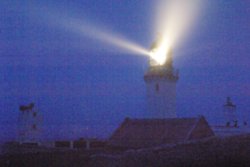
I decided that Durness was too far, and Dunnet Head was too foggy, so I would go to Duncansby Head or John O' Groats. After a quick nap, I left for Duncansby Head at 3am. I stopped in John O' Groats and to my dismay it was very foggy, so I continued on to Duncansby Head. Our progress slowed to a crawl; the road is a single lane and when there is oncoming traffic you have to pull over to let them pass. Why was everybody leaving? FOG. Tons of it, blowing stiffly in clumps and streams, with visiblity dipping to the tens of meters.
We returned to John O' Groats. Maybe the fog would lift after sunrise. Maybe... Maybe not. Well past the predicted time of sunrise the sky hadn't even brightened. A group of folks took off in a boat to see if they could get past the fog out at sea.
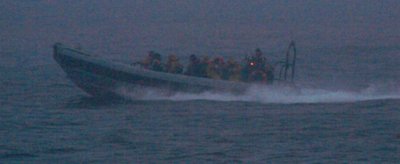
They returned rather quickly, so it must have been bad out there. We had nothing to do but sit, talk, and wait. As the appointed time for annularity came, we noticed that it got much darker. We were in the right place at the right time, but we wouldn't get to see the show. Below is a photo of the crowd gathered on the beach, during annularity. All of my camera equipment is ready and waiting in the lower left. Next is a view into the Sun, showing how bad the clouds were.
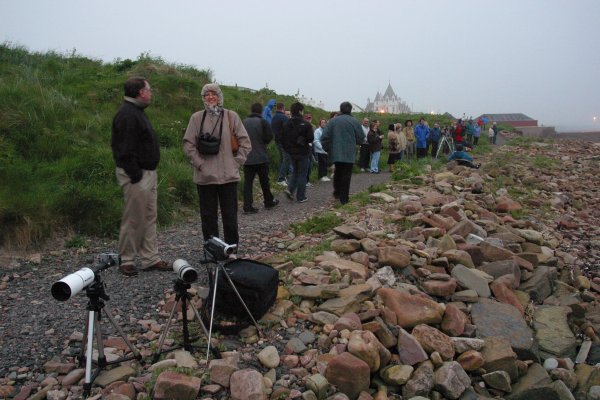
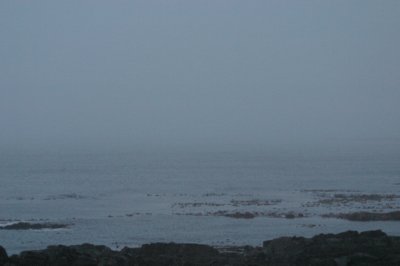
|
|
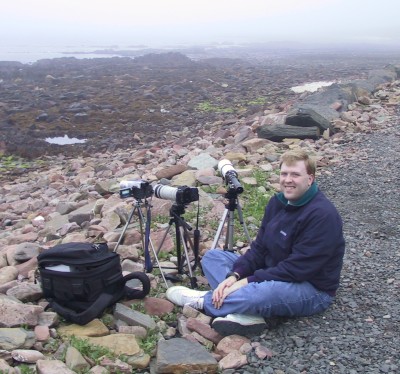
I waited another half hour to try and see the partial phase after the eclipse, but the clouds didn't even budge. I gave up and returned to my hotel for a couple more hours of sleep. Oh well, maybe next time!
In hindsight, I should have gotten going earlier the previous morning so that I would have had time to return to Durness. The weather was much better there and they got to see the eclipse. I don't mind missing the eclipse, because I saw so many other things in Scotland that the trip was very worthwhile and I wouldn't hesitate to do it again.
Despite being clouded out of the eclipse, I consider this trip to have been a resounding success because of all of the other things I saw. I have created a PDF format journal of the trip, rich with photographs. Choose from two versions:
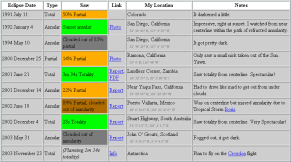
|
Please click here for photos and reports of other solar eclipses I have observed, attempted to observe, or plan to observe.
Time in totality: 4m 2s. Success rate: Totals 2 for 2, Annulars 1 for 3, Partials 3 for 4. |
Please visit my main astronomy page, or check out my homepage.
Comments? Questions? Click here to send email to me, Fred Bruenjes.
All text and images are © 2003 Manfred Bruenjes - All Rights Reserved. Image inlining (aka hot linking) and framing are strictly prohibited. Email for permission before using an image or text.